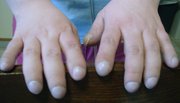Touraine-Solente-Golé syndrome
In medicine, clubbing (or digital clubbing) is a deformity of the fingers and fingernails that is associated with a number of diseases, mostly of the heart and lungs. Idiopathic clubbing can also occur. Hippocrates was probably the first to document clubbing as a sign of disease, and the phenomenon is therefore occasionally called Hippocratic fingers. more...
Signs and diagnosis
Clubbing develops in five steps:
- Fluctuation and softening of the nailbed (increased ballotability)
- Loss of the normal <165° angle ("Lovibond angle") between the nailbed and the fold (cuticula)
- Increased convexity of the nail fold
- Thickening of the whole distal finger (resembling a drumstick)
- Shiny aspect and striation of the nail and skin
When clubbing is encountered in patients, doctors will seek to identify its cause. They usually accomplish this by obtaining a medical history— particular attention is paid to lung, heart, and gastrointestinal conditions —and conducting a clinical examination, which may disclose associated features relevant to a diagnosis. Additional studies such as a chest x-ray may also be performed.
Disease associations
Isolated clubbing
Clubbing is associated with:
- Lung disease:
- Lung cancer, mainly large-cell (35% of all cases)
- Interstitial lung disease
- Tuberculosis
- Bronchiectasis
- Suppurative lung disease: lung abscess, empyema
- Cystic fibrosis
- Pulmonary hypertension
- Mesothelioma
- Emphysema (rarely)
- Heart disease:
- Any disease featuring chronic Hypoxia
- congenital cyanotic heart disease (most common cardiac cause)
- Endocarditis (not in acute cases, maybe subacute infective endocarditis)
- Atrial myxoma (benign tumor)
- Others:
- Crohn's disease and ulcerative colitis
- Hyperthyroidism (thyroid acropachy)
- Liver diseases (in the "hepatopulmonary syndrome", a complication of cirrhosis)
- Malabsorption
- Vascular anomalies of the affected arm (in unilateral clubbing)
Although many of these associations are recognised (such as the link with lung cancer), some are based on a few observations and might be false. Prospective studies of patients presenting with clubbing have not been performed, and hence there are no reliable numbers as to the distribution of the causes and the prognosis.
HPOA
A special form of clubbing is hypertrophic pulmonary osteo-arthropathy, known in continental Europe as Pierre Marie-Bamberger syndrome. This is the combination of clubbing and thickening of periosteum (connective tissue lining of the bones) and synovium (lining of joints), and is often initially diagnosed as arthritis. It is associated almost exclusively with lung cancer.
Read more at Wikipedia.org



